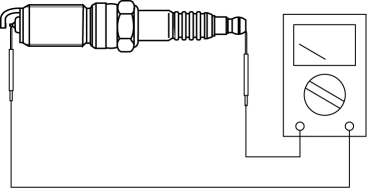Mazda 3 Service Manual: Spark Plug Inspection [Skyactiv G 2.0]
Specification
-
Spark plug type
-
PE01-18110, PE02-18110, PE5R-18110, PE5S-18110
Plug Gap Inspection
CAUTION:
-
To avoid possible damage to the tip, do not adjust the plug gap.
-
To prevent damaging the tip, use a wire type plug gap gauge when inspecting the plug gap.
1. Measure the spark plug gap using a wire type plug gap gauge.
-
If not within the standard specification, replace the spark plug.
-
Spark plug gap (PE01-18110, PE02-18110)
-
Standard: 0.75—1.10 mm {0.030—0.043 in}
-
New spark plug (reference): 0.75—0.85 mm {0.030—0.033 in}
-
Spark plug gap (PE5R-18110, PE5S-18110)
-
Standard: 1.05—1.40 mm {0.0414—0.0551 in}
-
New spark plug (reference): 1.05—1.15 mm {0.0414—0.0452 in}
Cleaning
CAUTION:
-
Carbon may adhere to the tip of the spark plug during vehicle delivery or repeated short distance driving during the winter time. If there is any malfunction such as rough idling or start difficulty due to carbon adhesion causing plug fouling, burn off the carbon by performing no-load racing of the engine.
-
When performing the no-load racing, apply the side brake and foot brake, move the shift lever to neutral (MTX), or the selector lever to P position (ATX) to prevent an accident and serious injury.
-
To avoid possible damage to the spark plug tip, do not use a wire brush for cleaning.
NOTE:
-
To avoid possible damage to the tip, use gasoline to clean the spark plugs after removing dirt.
-
If the accelerator pedal is depressed continuously for a specified time, the engine speed may decrease to the idle speed. This is due to the PCM control operation, which prevents overheating, and it does not indicate a malfunction.
-
Do not perform no-load racing at high engine speed continuously for 10 s or more
.
1. If there is carbon adhering to the spark plug, perform no-load racing at 4,000 rpm
for 2 min
, 2 times
.
Visual Inspection
1. Inspect the following items:

-
If any of the following malfunctions are indicated, replace the spark plug.
-
Insulator breakage
-
Worn electrode
-
Damaged gasket
-
Badly burned insulator (sparking side)
Resistance Inspection
1. Measure the resistance of the spark plug using a tester as shown in the figure.

-
If not within specification, replace the spark plug.
-
Spark plug resistance [25°C {77 °F}]
-
3.0—7.5 kilohms
 Spark Plug Inspection [Mzr 2.3 Disi Turbo]
Spark Plug Inspection [Mzr 2.3 Disi Turbo]
Specification
Spark plug type
L3BD-18110, L3YD-18110
Plug Gap Inspection
CAUTION:
To avoid possible damage to the tip, do not adjust the plug gap.
To prevent damaging t ...
 Spark Plug Removal/Installation [Mzr 2.0, Mzr 2.5]
Spark Plug Removal/Installation [Mzr 2.0, Mzr 2.5]
CAUTION:
If a spark plug that is not as specified is installed, engine performance
will be deteriorated. Install only the specified spark plug when replacing.
1. Remove the battery co ...
Other materials:
Operation of Automatic Air
Conditioning
Set the mode selector dial to the AUTO
position.
Set the air intake selector to the outside
air position (indicator light turned off).
NOTE
If the recirculated air position is used
for long periods in cold weather or high
humidity, the windshield may fog up more
easily.
Set the f ...
Neutral Switch Removal/Installation [G66 M R]
1. Remove the battery cover..
2. Disconnect the negative battery cable.
3. Remove the battery component. (ex: battery, battery tray and PCM component).
4. Remove the aerodynamic under cover No.2..
5. Drain the oil from the transaxle..
6. Remove the neutral switch.
7. Install the neu ...
Front Door Glass Removal/Installation
1. To access the glass installation bolt, position the front door glass so that
the distance from the top of the front door glass to the upper part of the front
beltline molding is approx. 80 mm {3.1 in}.
2. Disconnect the negative battery cable..
3. Remove the inner garnish..
4. Remov ...
